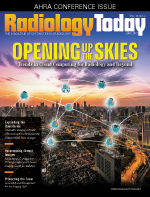 Ultrasound News: Shear Wave Elastography — A Business Case Study
Ultrasound News: Shear Wave Elastography — A Business Case Study
By Steven Cohen, MD, FACR
Radiology Today
Vol. 18 No. 6 P. 26
Radiology practices today are faced with many challenges. From the growing impact of health care reform and dwindling reimbursement dollars to the ever-increasing level of competition in the marketplace, the landscape has changed over the past few decades. Practices today, more than ever, must offer technology and services that not only provide a clinical impact for their patients but also have an impact on the economic health of the business year after year.
Recent studies and guidelines have established the accuracy and reproducibility of shear wave elastography (SWE), an ultrasound modality that uses fast-moving shear waves to quantify tissue stiffness.1,2 These measurements provide clinically useful information. Obtaining that information quickly, accurately, and without discomfort generates clear benefits to the patient as well as the practice. But what about the economic impact?
A Ripple Effect
The economics of elastography are intimately connected with the procedures SWE replaces and the treatments it leads to. Advances in treatment for hepatitis C, for example, have had a direct effect on the number of people who are candidates for medication and the likelihood that they will opt for treatment rather than monitoring alone. New hepatitis C medications work rapidly, have few side effects, and are more efficacious than the regimens they are replacing, making the decision to treat hepatitis C one with fewer trade-offs. At Advanced Radiology, a multilocation, Connecticut-based practice with just over 30 radiologists, demand for SWE evaluations of hepatitis C patients, as well as for those with steatosis and possible fibrosis, has increased threefold in the past year alone—to over 400 cases from 130. Why the sudden explosion of referrals?
The rise in SWE evaluations is due, in part, to the invasive staging procedure it can in some cases replace: biopsy of the liver. Referring physicians seeking to identify the stage of their patients' disease will find a noninvasive assessment of liver fibrosis to be a desirable alternative to a biopsy. Those same referring physicians need to check on their patients' progress after taking the medication, a situation that contributes to the greater number of SWE exams at the time of follow-up.
Added Value
The ease of SWE for the liver may seem to primarily benefit the patient: Not only is the exam faster and painless, the results can also be obtained immediately by the technologist performing the exam, thus speeding the patient's time to treatment. But that same speed benefits the radiology practice as well; the ability to perform a liver evaluation in the office, without the extra arrangements and additional delays necessitated by an invasive procedure, speeds throughput. When throughput is more efficient, the practice can accommodate more patients while generating equally accurate diagnostic information.
SWE is a boon to the efficiency of the radiology practice because a detailed image is so often required to assess and diagnose the patient. The ability to obtain such detail may have, prior to SWE, required a lengthier, costlier procedure such as MR elastography. While the results of MR will almost certainly yield more information, that extra information is very seldom necessary for a confident diagnosis and even less often worth the intricate setup, wait time for the patient, and additional cost. In fact, the ubiquity of MR machines in the United States makes MR a first-line procedure of choice more often than it should be. Health care reform and new appropriate use criteria address that overutilization and often push for an ultrasound assessment as the better first-line option.
The arrival of drastically improved hepatitis C medication has made SWE even more valuable to the radiology practice. Not only does it yield the necessary clinical detail to make a confident diagnosis in light of the now-available treatment, it also provides the practice with a potentially new revenue stream. Additionally, it is important to note that it is difficult to predict the advances in treatment to come or to know which risks, such as those associated with biopsy, will become less acceptable. As the clinical benefits of SWE continue to broaden, so too may the economic benefits to the radiology practice.
— Steven Cohen, MD, FACR, is a board-certified radiologist specializing in body imaging, ultrasound, and women's imaging at Advanced Radiology in Fairfield County, Connecticut, as well as Bridgeport and St. Vincent's Medical Center in Connecticut. He has been in practice for almost 30 years.
References
1. Ferraioli G, Tinelli C, Dal Bello B, et al. Accuracy of real-time shear wave elastography for assessing liver fibrosis in chronic hepatitis C: a pilot study. Hepatology. 2012;56(6):2125-2133.
2. Cosgrove D, Piscaglia F, Bamber J, et al. EFSUMB guidelines and recommendations on the clinical use of ultrasound elastography. Part 2: clinical applications. Ultraschall Med. 2013;34(3):238-253.

